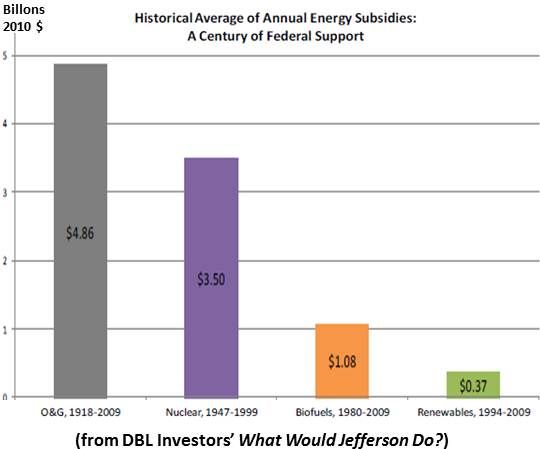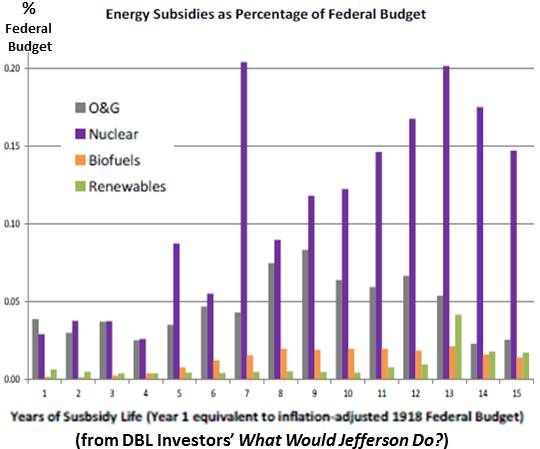To provide U.S. regulators a basis for decisions they will be making on controversial subsidies and incentives in state energy policies that may make or break renewables, a debate was added to the agenda at the National Association of Regulatory Utility Commissioners (NARUC) summer committee meetings.
“Energy subsidies have existed in the U.S. from the early days of wood,” DBL Investors Managing Partner Nancy Pfund said in reviewing the historical role of federal energy subsidies. “In wood, it was land grants and warrants for timber lands.” (What would Jefferson do?)
Over the first fifteen years of their subsidies’ durations, Pfund said, “federal support for non-renewables was much greater than for renewables.”
The oil and gas industry got five times what renewables got and nuclear got ten times the subsidies (in 2010 dollars). “Nuclear spent an average of about $3.3 billion a year, oil and gas about $1.8 billion, and renewable energy just under half a billion.”
Total subsidies to oil and gas, in place for nearly a century, are by far the most, Pfund said. And, she added, “as a percent of the federal budget, subsidies have always been at least 25 percent higher for oil and gas than for renewables.”
Coal’s “cumulative capital gains treatment on royalties from 2000 to 2009 totaled over $1.3 billion,” Pfund said, “compared to annual expenditures for renewables in those years of less than $1 billion.”
The oil and gas industries have Master Limited Partnerships (MLPs) and Real Estate Investment Trusts (REITs), Pfund said, two low-capital-cost ways of financing infrastructure now rapidly expanding in the financial services world. Neither is available to renewables investors, Pfund said, and both cost less than the tax equity funds derived from solar’s Investment Tax Credit (ITC) and wind’s Production Tax Credit (PTC).

“The U.S. government has also played a huge role in subsidizing natural gas infrastructure and technology,” Pfund added. “The combustion turbine was developed for aircraft and heavily subsidized. It was later reapplied to the gas sector.”
“In energy, the free market never has and never will meet all our energy needs,” Center for American Progress Clean Energy Investment Director Richard Caperton said. Without government intervention, energy-related externalities like climate change, environmental problems, and the needs of low-income consumers are likely to go unaddressed, he explained. “Subsidies are one way to do that.”
“Washington spin” and “misinformation and disinformation” were how American Petroleum Institute Chief Economist John Felmy characterized descriptions of his industry’s subsidies.
“The oil and gas industry,” Felmy said, “employs, directly and indirectly, nearly nine million Americans.” And, he reminded listening state commissioners, “your state pension funds are heavily invested in oil and gas companies, [so] when you hear arguments that they are going to take money from oil companies because they don’t need it, it’s going to come out of your pockets.”
Calling on regulators “to think thoughtfully about our policies,” he added, “We hear these arguments about whether or not we’re going to produce oil sands. Of course we’re going to produce oil sands. The oil sands of Canada are worth $14 trillion. The GDP of Canada is $1.4 trillion. The notion they wouldn’t be developed is silly.”
“When a technology shows promise but needs to get to the point where it will be cost-effective on its own, that may be a case for subsidy,” said Carnegie Mellon University Department of Engineering and Public Policy’s M. Granger Morgan, referencing recent studies.
Two other good cases for subsidies, Morgan added, are when an existing technology could reduce CO2, health or environmental damage but existing compensation schemes offer no way to pay for it and when planned new technology could reduce risks to critical services.
Historical evidence shows that sometimes, with economies of scale, a “technology will become competitive.” But sometimes a technology “is never going to get there.” Over the last two decades, Morgan said, wind “has been in that first category. Solar photovoltaic has not been.”

Before approving subsidies, Morgan cautioned, regulators must “address how a subsidy will be turned off once it is no longer needed.”
“What is the definition of a subsidy?” Felmy snapped. “In our industry, most of what is being characterized as a subsidy is not a subsidy; it’s a tax provision that every other industry gets.”
Subsidies for oil and gas are not simply tax provisions that everyone else gets, Caperton said, contradicting Felmy. He argued that they add the cost depletion allowance and the section 199 manufacturing tax deduction to Pfund’s mention of MLPs and REITs.
Regulators in the audience asked for more about when and how to turn a subsidy off.
“To think about when you are going to turn a subsidy off, you have to be clear about why the subsidy exists and what goal you’re trying to achieve,” Caperton said. “We don’t have that with a lot of subsidies right now.”
“A new study,” Pfund noted, “shows the ITC, when you look at it over the life of the credit, by creating these solar leases, provides a 10-percent return to the federal government. They are actually making money through this incentive through the revenues from all the companies in the solar supply chain.”
It is not when and how subsidies end, the study suggests, but when and how they transform. “It blows apart the notion that this is welfare at the taxpayer’s expense,” Pfund said. “Quite the opposite -- it’s a revenue generator.”



